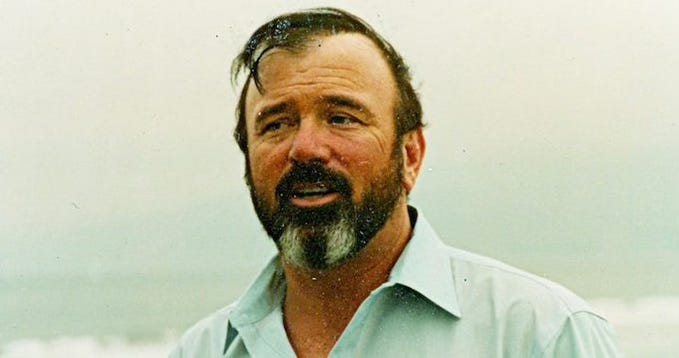R/T 022 - The Ghost in the Machine
This issue of Radical Things is about: Using Generative AI to extend human creativity.
I’ve avoided writing about Artificial Intelligence (AI) for months now. Everyone and their dog is now an AI expert or influencer. Many boosting the AI signal have a motive. Either they’re invested in the technology and narrative. Or they’re doing it for vanity, likes and internet clout.
I was in two minds about posting this article. But as I’ve put some effort into it, I’m hitting send anyway. So rather than spouting Sam Altman soundbites from two months ago, I'll tell you about how I’ve used generative AI.
Drop a like or a comment and tell me your thoughts about AI or how you’re using it.
The Ghost in the Machine
I’ve been using generative AI in the form of chat GPT, Midjourney and others for about two years now. I was on an early community call with Open AI researchers about using Dall-E. I also ran some 'Twitter Spaces' on generative AI for design. This was before Twitter turned into a dumpster-fire,
So although I’m not a computer scientist, I’m also not a naive recent convert.
My use has tapered in the last six months particularly. I’ve become more concerned about the ethical, moral and environmental implications of generative AI. I also find the FOMO (Fear Of Missing Out) across the customer-base startling.
It feels like the crypto-bubble but on a mass-scale. And if you were in the middle of that mess you know what happened. And how many who celebrated as leaders and savant’s ended up with criminal charges.
Whether Artificial General Intelligence (AGI) is possible is another discussion. Even if it is, it’s not around the corner, no matter what the nearest armchair futurist might tell you. The criteria for AGI keep getting looser and the timelines moving.
What seems clear is businesses like Open AI are aiming their sights on the creative industries. Their hypothesis is that you can pump masses of data through a pipeline. Then create so many variations of a thing that at some point you'll hit something useful. And that’s how creativity works.
Many creatives have also been infected with the romantic notion that an AI will augment what they do. By proxy they will become more creative.
I have a gut feel that Open AI would love you to have a creative partner-type GPT. It will end up harvesting so much data as to replace you. The goal is to drive down the cost of labour and replace you with a service they provide.
Ironically - you’ve done the hard work for them.
From a professional perspective, it would be foolish of me to bury my head in the sand and pretend it’s not happening. Working as a futurist and strategist it’s important to understand technologies. I also believe it’s essential to remain cautious about their application. Having a working understanding of the technology enables me to better advise clients. As well as helping them think about the future in more depth.
So at the risk of sounding like a hypocrite, I'd myself class as an early adopter of Chat GPT at version two. But here are a few examples of how I’ve used generative AI in my creative and futures-thinking practice.
Artificial Role-Play
One of the most interesting experiments I did early on was using Chat GPT in role-play. I was experimenting with using websites for Design Fiction. These become the artefacts from a near future that provoke new ideas, questions and critique.
I wanted to explore the concept of AI and what it might look like. To do this I prompted Chat GPT to play the role of an Artificial Intelligence from the future. I provided context then asked it to build a persona for itself.
After I created the prompt, I engaged in a conversations with the AI character - who named themselves 'Aria'. I asked them about their perspectives on issues. I also asked them to tell me about their AI collaborators and ‘friends’.
Now I understand I wasn’t having a conversation with an AI. I was asking it questions and I was getting “next best guess automatons” in response. But at times it felt eerily real - although on occasion I had to remind her who she was and what she was doing.
My conversations with ‘Aria” led to me discover the Autonomous Intelligence Collective.
Identifying the Average
For the last 18 months I’ve been digging into copywriting. I’ve also been part of an online copywriting community. As Chat GPT evolved, there were social media influencers selling copywriting tools. As we’ve seen on places like LinkedIn, we’re now inundated with AI responses. You're also prompted to “Write with AI’, which I always find nauseating.
I explored using specialised AI copywriting tools for web content early on. It was mind-blowing how fast they produced content. You can also try and hack Chat GPT by asking it to produce copy like a great writer. It could be the selling of Gary Halbert or some prose like Earnest Hemingway.
It made me wonder if many great writers were turning in their graves.
What was striking was how so much of what it spits out was “average but good enough”. If you want a bland corporate voice - then pump out some generic AI copy. After all, if the machine is producing the next best guess, it’s going to default to the average of the training data.
As Douglas Rushkoff recently lamented - this can show you what everyone else is doing. And what to avoid.
So use generative AI as a window to what much of the data set points to. Then use that as a springboard to create ideas at the edges.
Extending your Knowledge
As you extend your knowledge, you become more creative. You can also make new connections between disparate fields. Seeing patterns and recombining ideas to create new ones, a la Snowmobiling.
There are industries and sectors where you can place bets on the strength of data in the training set. Subjects like geopolitics, economics, education, environment, history are all likely candidates. You can inquire about unusual patterns, ideas and anomalies that a human may not see. You can also do this for data you might feed it.
It may only take one spark to fire you into a new direction or place. And a GPT can be a handy partner to surface something that creates a conceptual mismatch to send you down a new path.
Utilising the Bullshit
It's understood that chat GPT “hallucinates”. There was recently an academic paper stating how we should reframe this as “Bullshitting”.
But if you’re not an expert in the field you're playing in - it can be hard to call out the bullshit. You need to oscillate between the chat and reliable sources to sense-check the response.
But what if the bullshit was true? How might that prompt new thinking and ideas about what you’re looking at?
It’s a simple way to turn an AI bug into a creative feature.
Check your FOMO
There’s no doubt we need to think hard about our use of artificial intelligence (AI). Especially our use of generative AI. It’s clear that the big players don't want to lose this race. You can see the battlefield emerging in real time.
No matter what you might read - AI is not a done deal. There seems to be a prevailing attitude of “Well everyone else is doing it”. And “The genie is out of the bag”.
What I term “The Big AI Shoulder Shrug”.
Yet we can still do something about it. You don't have to use every AI tool because 'everyone else is'. You can be unsure and inquisitive, excited and nervous. At the end of the day you need to do what you believe is right.
There’s a broad spectrum of opinions about AI. I’d recommend listening to people who know about the space. There’s people who have a better understanding of how this technology might evolve. Many based in Silicon Valley or respected research institutions. If you see people spouting off opinions on social media, check their credentials. Do your own research. Build your own point of view.
I can't finish this piece with some pithy close. At the end of writing it, I’m still confused and uncertain about it AI and where it’s all heading.
Am I being too critical? Am I not being critical enough?
In such a fast-moving, ambiguous space, asking those questions repeatedly might be the best we can all do.
Watch
There’s a lot of movies about AI and one of my favourite is Ex Machina.
This was the directorial debut of Alex Garland. It’s about a developer at a tech company that wins a competition to engage in the ultimate Turing test.
It’s got great cast, stellar performances and the visual effects still hold up. It’s also still available on Netflix.
A lot of the live-action version of ‘Ghost in the Shell’ was filmed in Wellington. I can identify the streets in the CBD whenever I watch it.
Before this, there was the original animated version. Released in 1995, It follows a similar plot to the film, but retains the original manga-vibe.
I watched it on Netflix a few months ago. But the more recent 3D animated series ‘SAC-2045’ has repaced it. A series which critics panned.
A new animated version is in the pipeline. Let’s hope they don’t ruin it.
Listen
Amon Tobin creates electronic music. It sits somewhere between synthetic soundscape and electronic opera. The Brazilian is known for audio manipulation. Making his library of original sound recordings unrecognisable in his music.
Read
What do Silicon Valley Billionaires like Marc Andreessen really think?
Likelihood is you’ll never have dinner with a tech Billionaire. Never mind a group of them. Read this to find out what you’re missing.
In Technofascism, grey shirts are better than brown.
The title sums up what you should expect from this article. Worth a read for the insight into the minds of SF’s tech barons.
An article unpacking TESCREAL and what sits behind the AI hype.
What is TESCREAL? Find out in this article that unpacks the AI hype.
AI and the Holocaust
A new UNESCO report identifies the dangers of Generative AI rewriting history.
Opening remarks on “AI in the Workplace: New Crisis or Longstanding Challenge”
University of Washington Professor of Linguistics, Emily Bender, explains AI for a US Government panel.
The Five Stages of AI Grief
A super interesting article that critiques everything about AI - including the people and perspectives I’ve included about.
The Berggruen Institute has people like Elon Musk on the board, so bear that in mind.







